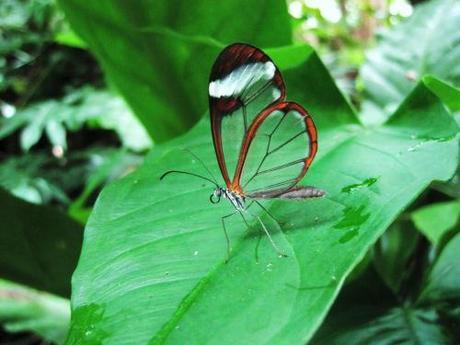 Glasswing butterfly
Glasswing butterfly
Did you know that chimpanzees and baboons in the wild eat some of the the same herbs and leaves as humans in parts of Africa do to treat malaria, diarrhea, and infections?
But this astounding ability to self-medicate isn’t just restricted to “higher” animals like primates with the cognitive ability “to observe, learn, and make conscious decisions.”
Kristina Chew writes for Care2.com, April 15, 2013, that according to Mark Hunter, a University of Michigan ecologist, and his colleagues, monarch butterflies and ants, fruit flies and moths are also “animal pharmacists” who seek out certain plants for their curative effects.
Even more astounding is that not only do these insects use plants to treat their own maladies, they also medicate others. As examples:
- Wood ants take an antimicrobial resin from conifer trees and incorporate it into their nests, to ward off microbial growth in the colony.
- Monarch butterflies who have become infested with parasites protect their offspring from those parasites by laying their eggs on milkweed, which is anti-parasitic.
- Honeybees collect antimicrobial resins and put these into their nests.
Perhaps the biggest surprise for us was that animals like fruit flies and butterflies can choose food for their offspring that minimizes the impacts of disease in the next generation. There are strong parallels with the emerging field of epigenetics in humans, where we now understand that dietary choices made by parents influence the long-term health of their children.
Scientists insist, however, that in the case of insects, using medication is an innate rather than a learned response. For instance, furry moth larvae known as wooly bear caterpillars have been observed to eat leaves of senecio (ragwort) to rid themselves of parasites. Eating these leaves fills them with alkaloids, which humans take in the form of caffeine, morphine and cocaine. Healthy wooly bear caterpillars also ingest small amounts of alkaloids so they become “unsavory” to predators — but if they eat too many, they can die.
The discovery that many types of insects self-medicate has a number of implications for “the ecology and evolution of animal hosts and their parasites,” says Hunter and his colleagues, as well as for understanding animal immune systems and our own.
Hunter concludes, “When we watch animals foraging for food in nature, we now have to ask, are they visiting the grocery store or are they visiting the pharmacy?” Plants are an important source of study to develop future medications, so observing which ones animals use to treat themselves could lead to the creation of new drugs for humans. To treat disease in ourselves, we’d do well to follow the flight of the butterfly.

